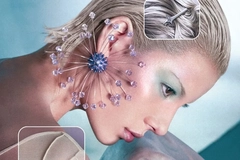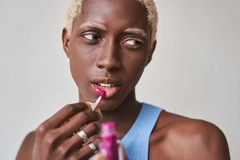Microplastics misconception: Study recommends closer look at leave-on products

Scientists from the University of Birmingham, UK, are concerned about the misconception of microplastics in leave-on personal care products such as lipstick, sunscreen, hand sanitizer, deodorant and nail polish. According to their recent study, regulators overlook leave-on products and the potential risks to human safety that long exposure causes.
Personal Care Insights speaks to Dr Anna Kukkola from the University of Birmingham about the analysis, which highlights that current research and global regulatory frameworks predominantly concentrate on rinse-off products, leaving a gap in consumers’ understanding of what products pose harm.
“The contribution of ‘leave-on’ cosmetics to microplastic pollution is a critical yet underexplored aspect of environmental contamination. These particles will eventually end up in wastewater treatment plants or landfills, from which they can reach aquatic environments.”
When asked what steps cosmetic brands can take to mitigate the potential environmental and health impacts of microplastics in their leave-on products, Kukkola responded, “this is simple, leave them out of the formulations.”
The research found that only two of the 2,381 products studied were leave-on products. The scientists claim that could be due to the difficulty of extracting microplastics from complex oil-based formulations versus rinse-off products like facial scrubs.
The study suggests another potential reason for the lack of research in this area could be public perception “driven by industry advertising that the microplastic issue in such items has been adequately handled when this is, in fact, far from the case.”
“The only regulatory measure adequately handling leave-on cosmetics is the new EU microplastic ban, which comes into effect in stages — from 2027 for rinse-off cosmetics, in 2029 for leave-on cosmetics and not until 2035 for lip, nail and makeup products, as all others focus only on rinse-off products,” says Kukkola.
Health risks
The study highlights multiple routes through which leave-on product ingredients can be absorbed into the body, depending on how they are applied. For example, with lipsticks, microplastics could be accidentally consumed in small amounts or absorbed through the skin in hair follicles or sweat ducts.
“Given how much of these formulas our bodies can and do absorb, it is concerning that little to no research has taken place to investigate the associated health effects.”
Iseult Lynch of the University of Birmingham notes, “While the microplastics themselves might be relatively benign, a number of other chemicals are intrinsically bound into or onto the microplastics in complex leave-on formulations.”
Chemicals could include PFAS, plasticizers and others known to be carcinogens or endocrine disruptors.  Scientists are concerned about the misconception of microplastics in leave-on personal care products such as lipstick.
Scientists are concerned about the misconception of microplastics in leave-on personal care products such as lipstick.
What challenges exist in testing leave-on cosmetic formulations for microplastic content compared to rinse-off products?
Kukkola: Testing for microplastics in leave-on cosmetics, like foundation, moisturizers, and sunscreens, is more challenging than rinse-off products (like shampoos or body washes). This is because rinse-off products dissolve easily in water, making it simpler to separate the microplastics (as they do not dissolve in water).
However, leave-on products have more complex formulations, often containing oily or water-resistant ingredients like esters, fatty alcohols or silicones. These don’t dissolve as easily in water, making it harder to isolate the microplastics. Additionally, some methods used to break down these complex ingredients might damage the microplastics, which adds another layer of difficulty to the testing process.
How do you think public perception has influenced the lack of attention to microplastics in leave-on products?
Kukkola: This is a difficult question to answer, as it is a bit of a chicken and an egg situation. Because of heightened consumer consciousness the first microbead bans came into force (such as The Microbead-Free Waters Act of 2015 in the US, however, despite good intentions, global legislation has not been fully comprehensive, focusing only on “microbeads,” a term used by the cosmetic industry to describe specific types of microplastics added to rinse-off personal care products.
Microbeads are defined as intentionally added, water-insoluble plastic particles, 5 mm or smaller, used to exfoliate or cleanse. This definition, popularized by the 2015 Act, became widely adopted by both legislators and the industry worldwide.
As a result, leave-on products were specifically excluded from these regulations, which only target microplastics in rinse-off products. Over time, the term “microbead” became synonymous with microplastics in the minds of many consumers and companies have often stated that they are “phasing out microbeads,” which, while technically accurate, only refers to rinse-off products designed for scrubbing.
This language may have unintentionally led consumers to believe that none of the company’s products contain microplastics, contributing to a perception that these issues have been fully addressed.
Why has there been a regulatory delay in addressing microplastics in leave-on products, and how might the EU’s 2029 ban impact the industry?
Kukkola: I believe that regulatory action often requires strong evidence, especially when dealing with products that have significant market value. It’s also possible that regulators were not fully aware of the presence of microplastics in leave-on products until more recently, although this is just my personal assumption.
That said, the EU is applying the precautionary principle in this case — acting because there is evidence of harm, even if we do not yet fully understand the extent. The 2029 ban will likely impact the industry, as many products will need to be reformulated to comply with the new regulations. However, I’m not an economist, so I can’t speak to the specifics of how this might affect the industry or market.
With additional reporting from Venya Patel












